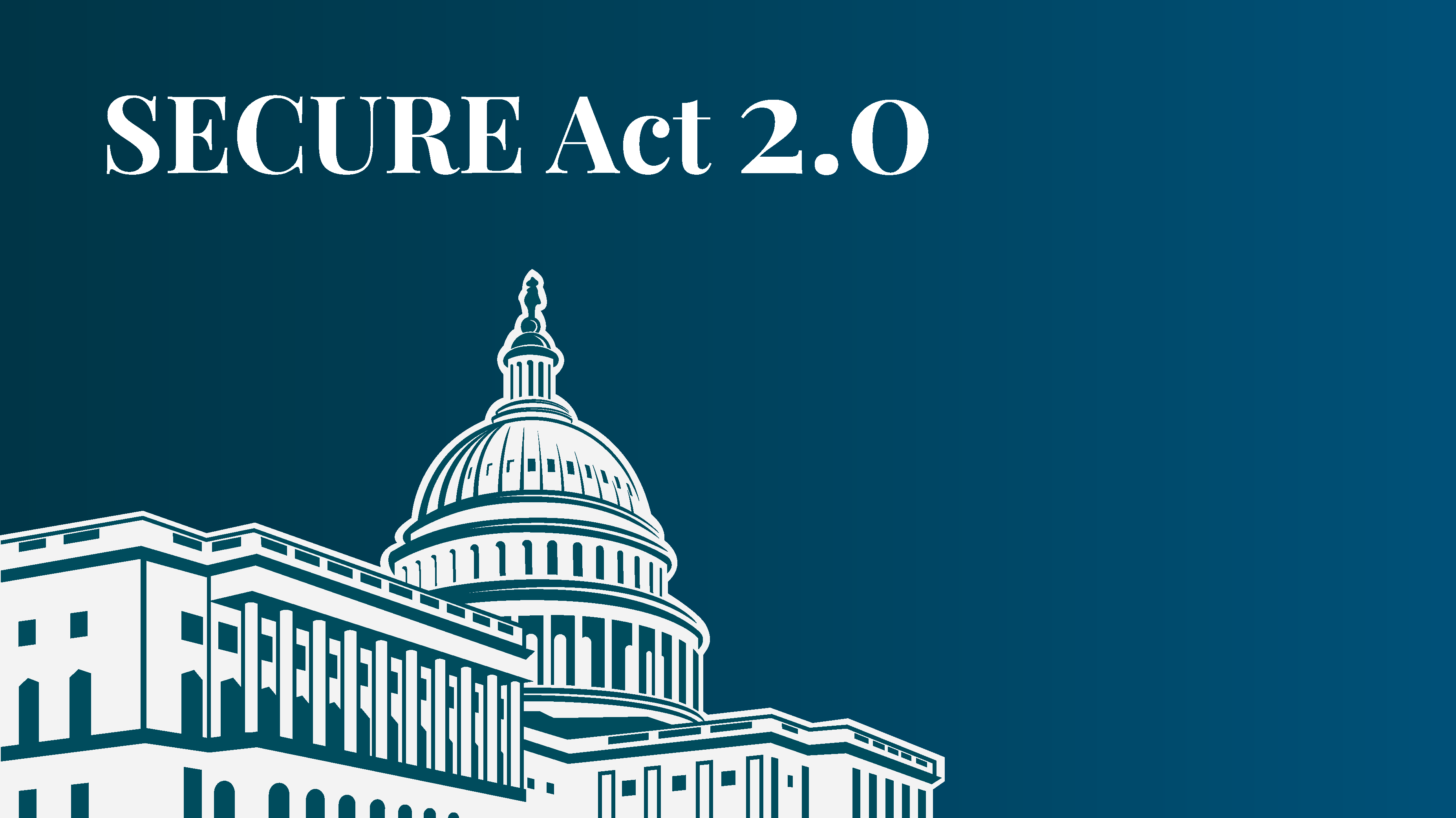
Many Abacus blogs focus on overall retirement and investment strategies or other long-term goals and planning. Occasionally, there are big new pieces of federal legislation that deserve a increasingly granular look. This unenduring review can potentially help you on several new financial fronts.
On December 29, 2022, the SECURE Act 2.0 was signed into law by Congress. As you may recall, the original SECURE Act (2019) made several changes that impacted retirees:
- Helped small merchantry owners’ worthiness to create “safe harbor” retirement plans
- Delayed the required minimum distribution (RMD) age from 70 ½ to 72
- Opened investment opportunities in 401(k)s (such as annuities)
- Required non-spouse IRA inheritors to take distributions that empty the inherited worth within ten years
- Opened up employer retirement savings benefits to part-time employees
- Gave a $500 tax credit to businesses who set up will-less enrollment in their visitor 401(k) for employees
- Allowed 529 Plan funds to pay up to $10,000 toward student loans (lifetime limit per beneficiary)
Allowed a penalty-free withdrawal up to $5,000 for plan participants having or raising a child to offset costs
The initial goal of the SECURE Act was to encourage retirement savings and make it easier for businesses to support their employees with these types of benefits.
SECURE Act 2.0 moreover aims to create increasingly retirement savings opportunities for U.S. workers. The Act has six sections that imbricate everything from retirement savings finance to savings preservation.
Here’s a dispersal of the most notable changes from SECURE 2.0 that may impact you.
Required Minimum Distribution (RMD) Age Change

The original SECURE Act shifted the RMD age from 70 ½ to 72. In 2023, under SECURE Act 2.0, that age changes from 72 to 73. In 2033, the age will transpiration to 75.
For many retirees, the number of RMD age changes may come as a surprise. Revisions to the RMD age requirement (previously 70 ½) haven’t been made since they were initially instituted as part of the Tax Reform Act of 1986.
However, these changes provide unique planning opportunities for retirees and those with finance requiring RMDs, such as 401(k)s, 403(b)s, and 457(b)s, who aren’t ready to retire or who can postpone taking funds from retirement finance (and stave the taxes on those funds).
Delaying your RMDs a few years may offset taxable events or help you strategically plan your mazuma flow. Additionally, the SECURE Act 2.0 reduces the penalty for lightweight to take RMDs from 50% to 25%.
To recap, from 2023 to 2032 you can wait until age 73 to take your RMDs. Starting in 2033, you can wait until you’re 75.
529 Plan Updates
The SECURE Act 2.0 creates a new rule to let families move leftover funds in a 529 Plan to a Roth IRA for the plan’s beneficiary. There are, however, several requirements and limitations:
- The transpiration will take effect in 2024
- Qualifying rollovers are tax- and penalty-free
- The 529 Plan must have been unshut at least 15 years
- Beneficiaries can roll over a maximum of $35,000 throughout their lifetime, up to the maximum yearly Roth IRA contribution limit; in other words, if the 529 Plan worth payee is under 50, they can roll over $6,500 each year until they reach the lifetime $35,000 limit
- The 529 Plan payee can be reverted surpassing a rollover is made; this can help parents take funds in a 529 Plan and distribute them to all their children or beneficiaries over several years
Retirement Savings
Whether you’re an employer or an employee, several changes have been made for those involved in a company-wide retirement savings plan like a 401(k) or 403(b).
For Employees:
- Higher catch-up contributions are unliable for individuals between the month of 60 to 63; catch-up contribution limits for this age group will increase to $10,000/year in January of 2025, with some exceptions; these limit increases wield to 401(k)s, 403(b)s, and 457 plans
- Employers/plan sponsors can treat “qualified student loan payments” as elective deferrals for matching contributions to an employee’s retirement account
- Employers can provide contribution matching to Roth accounts
For Employers and Businesses:
- All new 401(k) and 403(b) plans must have an will-less enrollment full-length ranging from 3% to 10%. This is true for businesses with increasingly than 10 employees
Retirees:
- People who have Roth 401(k)s or 403(b)s will not have to take RMDs
ABLE Worth Eligibility
ABLE accounts are tax-advantaged savings finance for individuals with disabilities and their families. Historically, to qualify for an ABLE account, an individual must have had an onset of powerlessness at or prior to age 25.
The SECURE Act 2.0 increases this age limit to 46, letting those with powerlessness onset later in life to qualify. This is particularly valuable for those who may develop mental health conditions like schizophrenia, where symptoms may not manifest until age 25 or later.
Have Questions?
These are just a few of the biggest changes in the SECURE Act 2.0, but the laundry list of items the legislation covers is long. If you have spare questions, you can find a well-constructed overview of the SECURE Act 2.0 on the Senate’s website.
As always, if you have any questions regarding changes from the SECURE Act 2.0, please don’t hesitate to reach out. Abacus is unchangingly here to offer clarity and help.
Disclosures
Please remember that past performance is no guarantee of future results. Different types of investments involve varying degrees of risk, and there can be no warranty that the future performance of any specific investment, investment strategy, or product (including the investments and/or investment strategies recommended or undertaken by Abacus Wealth Partners, LLC [“Abacus”]), or any non-investment related content made reference to directly or indirectly in this blog will be profitable, equal to any respective indicated historical performance level(s), be suitable for your portfolio or individual situation, or prove successful. Due to various factors, including waffly market conditions and/or workable laws, the content may no longer be reflective of current opinions or positions. Moreover, you should not seem that any discussion or information contained in this blog serves as the receipt of, or as a substitute for, personalized investment translating from Abacus. To the extent that a reader has any questions regarding the applicability of any specific issue discussed whilom to their individual situation, they are encouraged to consult with the professional counselor of their choosing. Abacus is neither a law firm nor a certified public written firm and no portion of the blog content should be construed as legal or written advice. A reprinting of Abacus’s current written disclosure brochure discussing our newsy services and fees is misogynist for review upon request or at https://abacuswealth.com/.
Please Note: Abacus does not make any representations or warranties as to the accuracy, timeliness, suitability, completeness, or relevance of any information prepared by any unaffiliated third party, whether linked to Abacus’s website or blog or incorporated herein, and takes no responsibility for any such content. All such information is provided solely for convenience purposes only and all users thereof should be guided accordingly.
Please remember, if you are an Abacus client, please contact Abacus, in writing, if there are any changes in your personal/financial situation or investment objectives for the purpose of reviewing/evaluating/revising our previous recommendations and/or services, or if you would like to impose, add, or to modify any reasonable restrictions to our investment newsy services. Unless, and until, you notify us, in writing, to the contrary, we shall protract to provide services as we do currently. Please moreover remember to teach us if you have not been receiving worth statements (at least quarterly) from the worth custodian.





